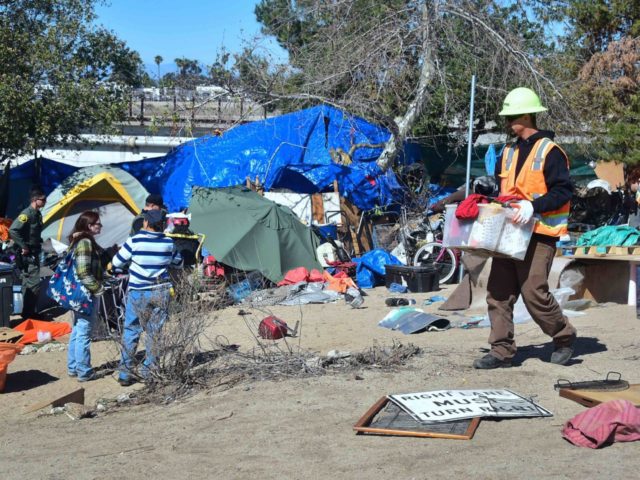(Total Views: 291)
Posted On: 03/25/2018 7:14:30 PM
Post# of 52071

Re: OldSaltDawg #30308
Orange County Cities Fight New Tent Camps for Homeless
< >

The three cities where Orange County planned to erect tent camps to warehouse evicted Santa Ana River homeless people are threatening lawsuits to block the move.
It took over a decade of legal battles for the County of Orange to evict about 1,000 campers along the Santa Ana River. The county on Feb. 26 signed a voluntary resettlement agreement with social justice attorneys representing homeless plaintiffs and negotiated by U.S. District Judge David O. Carter.
Terms of the deal required the county to recognize the civil rights of homeless people by temporarily providing 400 motel rooms and creating 700 permanent homeless shelter beds. Local cities agreed to join the community effort to adding 2,700 transitional housing units.
But after spending about $780,000 over 30 days on hotel rooms, the Orange County supervisors agreed on March 19 to spend a total of about $90.5 million to house the homeless permanently. But during the interim, the supervisors directed Public Services to set up temporary tent camps on county-owned parcels in Irvine, Huntington and Laguna Niguel.
The cities were completely caught off guard. After Irvine City Council members learned that the 200 homeless would be placed in tents bordering Orange County’s Great Park, council members claimed the site is contaminated and uninhabitable under California environmental laws, according to Southern California Public Radio.
When the Laguna Niguel found out the County intended to site a 100-person tent community on land adjacent to its downtown, the City voted on March 20 to file a lawsuit. Mayor Elaine Gennawey issued a statement that she was “outraged by the Orange County Board of Supervisors’ poorly thought out decision.” She added, “They have had years to address this issue, and they are the ones who put themselves in this ‘time crunch’ with an apparent limitation of ill-advised options.”
The biggest concerns expressed by the cities is the risk to public health from infectious diseases. When OC Public Works cleaned up the Santa Ana River campgrounds, they removed 5,279 pounds of human waste, 404 tons of trash, and 13,950 needles. The biohazard risk is so high that the County intends to remove and burn three inches of topsoil along a two-mile stretch of the bike trail, and then seal the area with an asphalt slurry.
Breitbart News reported that a hepatitis A outbreak began among San Diego’s homeless population and has spread statewide and entered the general population. The California Department of Public Health’s most recent bi-weekly hepatitis A report revealed 703 new cases, 460 hospitalizations, and 21 deaths.
Other infectious disease outbreaks that began in homeless encampments include new strains of tuberculosis that emerged in Northern California homeless camps; a deadly new strain of Streptococcus that killed three homeless in Anchorage; and a Shigella food borne illness that causes bloody diarrhea, which began in Portland’s homeless camps.
< >

The three cities where Orange County planned to erect tent camps to warehouse evicted Santa Ana River homeless people are threatening lawsuits to block the move.
It took over a decade of legal battles for the County of Orange to evict about 1,000 campers along the Santa Ana River. The county on Feb. 26 signed a voluntary resettlement agreement with social justice attorneys representing homeless plaintiffs and negotiated by U.S. District Judge David O. Carter.
Terms of the deal required the county to recognize the civil rights of homeless people by temporarily providing 400 motel rooms and creating 700 permanent homeless shelter beds. Local cities agreed to join the community effort to adding 2,700 transitional housing units.
But after spending about $780,000 over 30 days on hotel rooms, the Orange County supervisors agreed on March 19 to spend a total of about $90.5 million to house the homeless permanently. But during the interim, the supervisors directed Public Services to set up temporary tent camps on county-owned parcels in Irvine, Huntington and Laguna Niguel.
The cities were completely caught off guard. After Irvine City Council members learned that the 200 homeless would be placed in tents bordering Orange County’s Great Park, council members claimed the site is contaminated and uninhabitable under California environmental laws, according to Southern California Public Radio.
When the Laguna Niguel found out the County intended to site a 100-person tent community on land adjacent to its downtown, the City voted on March 20 to file a lawsuit. Mayor Elaine Gennawey issued a statement that she was “outraged by the Orange County Board of Supervisors’ poorly thought out decision.” She added, “They have had years to address this issue, and they are the ones who put themselves in this ‘time crunch’ with an apparent limitation of ill-advised options.”
The biggest concerns expressed by the cities is the risk to public health from infectious diseases. When OC Public Works cleaned up the Santa Ana River campgrounds, they removed 5,279 pounds of human waste, 404 tons of trash, and 13,950 needles. The biohazard risk is so high that the County intends to remove and burn three inches of topsoil along a two-mile stretch of the bike trail, and then seal the area with an asphalt slurry.
Breitbart News reported that a hepatitis A outbreak began among San Diego’s homeless population and has spread statewide and entered the general population. The California Department of Public Health’s most recent bi-weekly hepatitis A report revealed 703 new cases, 460 hospitalizations, and 21 deaths.
Other infectious disease outbreaks that began in homeless encampments include new strains of tuberculosis that emerged in Northern California homeless camps; a deadly new strain of Streptococcus that killed three homeless in Anchorage; and a Shigella food borne illness that causes bloody diarrhea, which began in Portland’s homeless camps.
